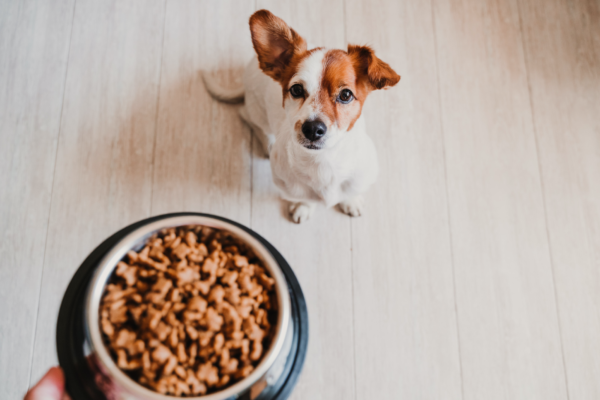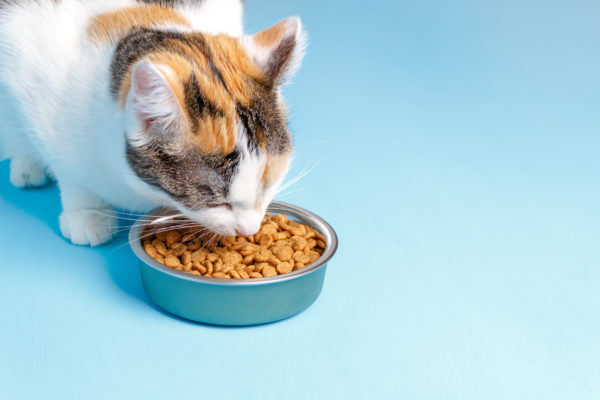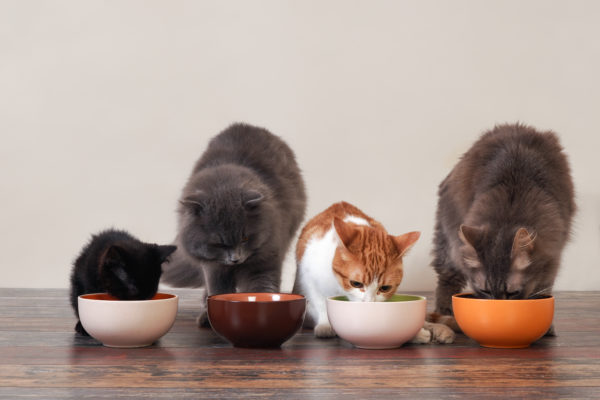THE 5 GOLDEN RULES OF CAT AND DOG NUTRITION
Your pet’s personality is unique—one of the many things you love about them! That’s why your Globalvet team gives you tailored advice during consultations; whether it’s about your pet’s care, behaviour, or nutrition. But when it comes to pet nutrition, there are certain core principles that apply to all the fur babies out there. In this post, Globalvet presents the 5 golden rules of nutrition for your cat or dog that you should be following!
1. QUALITY AND QUANTITY: CHOOSE WISELY
QUALITY
Of course, you care about the quality of the food you give your pet! Feeding them a high-quality diet is one way to help keep their body strong so your furry companion stays by your side for as long as possible.
Your intentions are good, but how can you tell one quality food from another? Your pet’s food should have proteins, fats, carbohydrates, vitamins, micronutrients, and minerals in the right amounts. It should also be targeted to their life stage, any health issues, and indoor or outdoor lifestyle. Things are getting a little complicated!
Your veterinary team is here to provide you with guidance in choosing the right food for your companion. The pet foods sold in veterinary clinics are proven to be top quality. How can you be sure?
- They’ve passed clinical trials demonstrating their unique health benefits.
- They’re formulated by veterinary nutritionists and include:
- A balance of quality ingredients combining protein, fat, carbohydrates, fiber, vitamins, and minerals to meet your pet’s nutritional needs
- Ingredients selected for their nutritional value, quality, and taste
- A healthy diet doesn’t depend on just one or even a few ingredients: A complete and balanced pet food is the sum of all of its parts
- Traceability and ingredient safety are central to the manufacturing process.
QUANTITY
How much food are you feeding your pet? Is their bowl always full? Ideal feeding amounts actually depend on a number of factors, including your pet’s:
- Species
- Breed
- Size
- Body composition
- Age (life stage)
- Level of physical activity
- Living environment
Serving sizes may vary from one food to another because pet foods contain different energy (caloric) and nutrient densities. Using the manufacturer’s recommendations on the packaging as a guide is always an option, but keep in mind that they aren’t tailored to your individual cat or dog and their unique requirements. Your veterinary team is there to help you make sense of it all and tell you exactly how much you should be feeding your pet.
2. BE CONSISTENT
Once you’ve determined how much to feed your pet, consistency is key to maintaining a healthy weight. You not only have to be consistent in how much you put in their bowl, but also how often you fill it!
We don’t recommend free feeding, even for puppies and kittens, because it gives your pet access to excessive amounts of food. Did you know that overeating is one of the main factors that contribute to pet obesity? A little extra kibble in the bowl can quickly become a few too many pounds on the scale! So why not practice good habits from the start? The portions recommended by your veterinary team take all your pet’s needs into account, whether they’re still growing or more mature.
How do you make sure you’re being consistent in how much you’re feeding your pet? The best way is to weigh their meals.
Here’s a tip: Portion out multiple meals in advance and store them in small resealable bowls. You’ll save time by not having to drag out the scale every day. A measuring cup is a simple solution, but also a lot less accurate because you may end up heaping it a little too high without realizing it. You may think “What’s the big deal—it’s only a few extra pieces of kibble?” but over time it can lead to weight gain.
Did you know that on average, just 4 to 8 extra pieces of kibble is the equivalent of feeding your pet 10% too much? That’s like you eating 2 extra slices of bacon a day!
Now that we’ve talked about consistency in quantity, what about consistency in scheduling? How many times a day should you feed your pet?
The answer may vary depending on their age and size:
- Kittens: 3 to 6 times a day
- Large breed puppies: 3 to 4 times a day
- Small breed puppies: 4 to 6 times a day to reduce the risk of hypoglycemia
You can decrease the number of meals as your puppy or kitten grows. Twice daily feeding is generally recommended for healthy adult pets.
A consistent feeding routine is also important. For starters, it’s a good idea to have set meal times so you don’t upset your pet’s digestive system. Some pets tend to vomit if they chow down on an empty stomach. Also try to feed your cat or dog at the same time and in the same place every day: It will encourage normal elimination habits and help prevent accidents.
3. DON’T GIVE IN TO BEGGING
We all deserve a little treat on occasion, right?! It’s only natural you’d want to show your pet the same love from time to time…or maybe all the time…
When given in moderation, treats can be part of a healthy diet for a pet. Would you (should you) eat French fries every day? No, but splurging now and again is okay. The same goes for your cat or dog! Just take note of the calories and make sure treats don’t account for more than 10% of their daily intake. To maintain a balanced diet, the calories provided by treats need to be subtracted from their daily food amount. Your veterinary team can help you do the math. If you’ve got a snacker on your hands, take some kibble out of their daily ration to hand out as mini rewards and save the real treats for training purposes or when your cat or dog is on their best behaviour.
As much as your pet may love table scraps, they may not love your pet back. Human food is usually high in calories and fat and can cause stomach upset in pets, so think twice about sharing your supper. Not only can leftovers contribute to obesity, but some of the ingredients may even be toxic to your pet! That’s why our recommendation is simply to avoid giving table scraps all together. It will help prevent health problems and discourage bad behaviour, such as begging. If you can’t resist, give your pet small amounts of low-calorie fruits and vegetables (except grapes and onions, which are toxic to cats and dogs).
We strongly advise only using treats made specifically for pets. Plus, treats are great for behaviour training — positive reinforcement is one of the best ways to motivate your pet to keep up the good work!
What to do if you have a chowhound on your hands, or a tubby tabby who meows for more? It can be hard to resist those puppy dog eyes or that gentle paw reaching out, but it’s really important not to overfeed your pet. While begging may be cute, it can lead to other behavioural problems, not to mention obesity. Try feeding your pet smaller amounts, but more often, or using a toy or bowl that forces them to work for their food.
4. LISTEN TO YOUR PET
It would be great if your pet could talk, wouldn’t it?! But since they can’t, you have to pay close attention to non-verbal cues—especially when it comes to a proper diet.
Look for hints that your furry companion isn’t getting their nutritional needs met in one way or another. A few signs that their diet or digestion need a closer look include:
- Bad breath
- Body odour
- Dandruff
- Dull coat
- Stool issues (too soft, too hard, too much, not enough)
- Flatulence
- Hair loss
- Obesity
- Skin conditions
- Weight loss
Symptoms like these may mean you need to upgrade your pet’s food. If they have a deficiency of nutrients like vitamin D, calcium, or protein, your cat or dog may end up with serious health issues that have irreversible consequences.
Also look for signs that you’re over or under feeding your pet. A lack of proper nutrients can lead to poor nutrition, but so can an excess. Everyone knows that consuming more calories can contribute to obesity, but did you know that an overabundance of certain nutrients like vitamin A and phosphorous can also cause a dangerous imbalance?
So be on the lookout for any of these signs. Your veterinary team can help you decipher what they mean!
5. SPICE THINGS UP
Ever compare your rich and varied diet to your pet’s same-old, same-old, and feel a pang of guilt? Only natural! You get access to a smorgasbord of food options while your pet has to settle for kibble and the occasional treat. Looking for ways to make things more interesting and stimulating? We’ve got some solutions!
ALTERNATE BETWEEN KIBBLE AND CANNED FOOD
Why is this a good strategy?
- It exposes your pet to different textures.
- It can help prevent urinary problems.
- It helps maintain a healthy weight.
Here’s a tip: Introduce your kitten or puppy to different foods and textures—including dry kibble, canned food, and treats—within the first 4 months. At that age, they’re more willing to try something new and look back on it fondly. Hopefully it will be easier for them to accept any diet changes you need to make later on.
USE DIFFERENT FEEDING STRATEGIES
Feeding strategies are beneficial for a number of reasons:
- They force your pet to slow down while eating.
- They exercise your pet’s brain, paws, and mouth.
- They meet your dog’s need for mental stimulation and their drive to chew.
- They satisfy your cat’s hunting instinct.
To learn more about feeding strategies, check out our posts on the topic specifically for cats and for dogs.
REWARD GOOD BEHAVIOUR
Treats are an important tool in your relationship with your pet and can really enhance their diet and make life more enjoyable:
- Your pet gets to try out different flavours and textures.
- Treats can be a powerful motivator for good behaviour.
- You can use them to create a positive association with something less interesting.
To make sure the treats you choose don’t create an imbalance in your pet’s diet, ask your veterinary team for advice before making a change. They can recommend kibble, wet food, treats, and feeding strategies that are right for your pet and show you how to juggle it all without overfeeding.
Want to learn more about feeding your pet? Browse our Nutrition section, where our expert teams delve into a range of topics.



